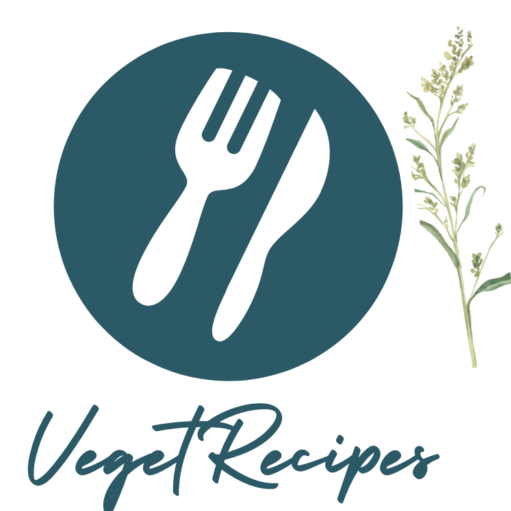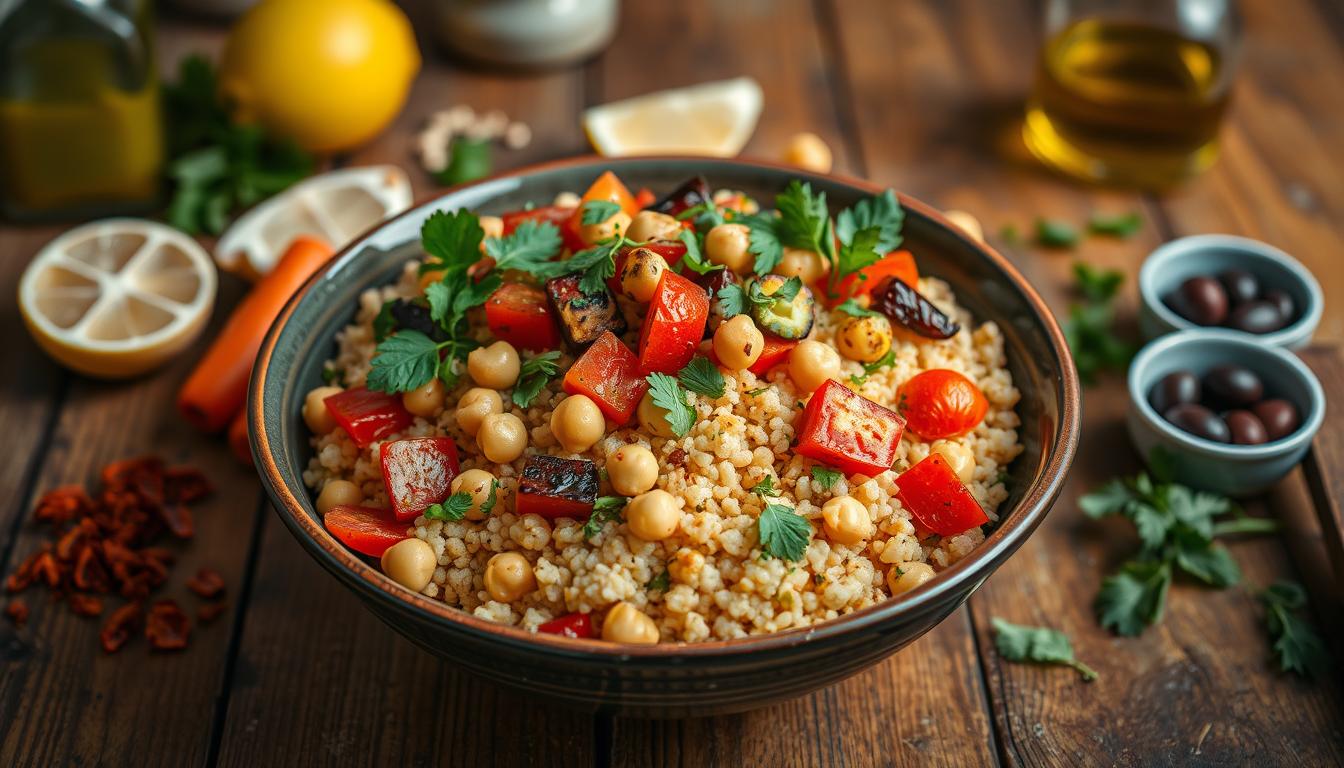Vegetarian couscous recipes open a world of rich flavors and options. Couscous, a versatile grain, is perfect for many vegetarian dishes. These recipes range from simple meals to vibrant, festive dishes. They are great for those who care about their health, combining nutrition with delicious taste without meat.
Each couscous vegetarian recipe balances taste and nutrition. Whether you need a quick dinner or a dish for a special event, vegetarian couscous is perfect. Let’s discover the vibrant world of these tasty, meat-free recipes together.
Key Takeaways
- Vegetarian couscous recipes offer a nutritious and flavorful alternative to meat-based dishes.
- Couscous is a versatile grain that can be used in various vegetarian recipes, from quick dinners to festive meals.
- These recipes are ideal for health-conscious individuals, combining taste and nutrition.
- Common ingredients in these recipes include olive oil, vegetables, chickpeas, and a mix of spices and herbs.
- Serving suggestions and tips for preparation ensure satisfying and delicious meals every time.
Introduction to Vegetarian Couscous Recipes and Its Varieties
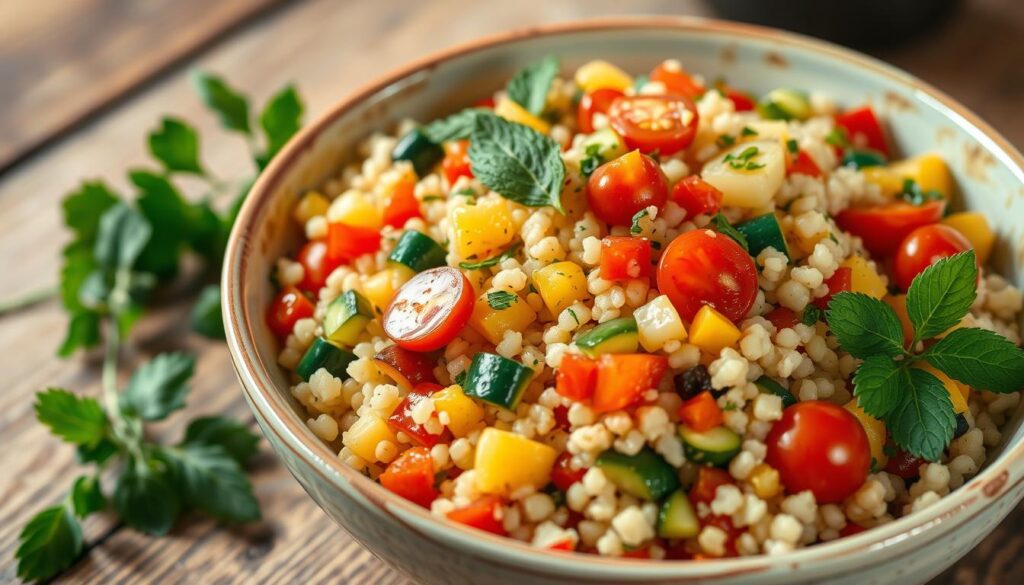
Couscous is a versatile ingredient perfect for vegetarian dishes. This section explains what couscous is, its types, and uses in vegetarian cooking. Knowing these details can make your meals nutritious and satisfying.
What is Couscous?
Couscous is a small pasta made from semolina or whole-wheat flour. It cooks quickly and has been a North African staple for centuries. It’s enjoyed in Morocco, Algeria, and Tunisia, and is now popular worldwide for its convenience and adaptability.
Types of Couscous
The three main types of couscous differ in size and texture:
- Moroccan couscous: The smallest, cooks quickly, and has a light, fluffy texture.
- Israeli couscous: Larger, chewy, and perfect for hearty dishes. It’s great for israeli couscous recipe vegetarian dishes.
- Lebanese couscous: Large pearls, resembling small peas, need longer cooking and have a unique texture.
Common Uses in Vegetarian Dishes
Vegetarian couscous recipes showcase its versatility. It’s a nutritious base for salads, stews, and stuffed vegetables. For instance, a pearl couscous recipes vegetarian might include roasted vegetables, chickpeas, and fresh herbs. Couscous fits well into Mediterranean and Middle Eastern cuisines, making it great for health-conscious cooks.
Ingredients You Need for Vegetarian Couscous Recipes
Want to make your couscous recipes better? You need the right ingredients. Let’s look at the basics, fresh veggies, and spices for a tasty vegetarian couscous.
Staples for Your Pantry
First, make sure your pantry has the essentials. Here’s a quick list:
- Couscous Varieties: Have different types like Moroccan and pearl couscous. Israeli (pearl) couscous is like pasta.
- Olive Oil: It’s great for cooking veggies and adding flavor.
- Basic Seasonings: Salt and pepper are key for any dish.
Seasonal Vegetables
Using fresh veggies makes your couscous better. Here are some good choices:
- Zucchini: It’s tender and nutritious.
- Tomatoes: They’re juicy and add flavor.
- Onions: Sweet when cooked.
- Bell Peppers: Crunchy and colorful.
- Mushrooms: They add a rich flavor.
Must-Have Spices and Herbs
Spices and herbs make couscous taste great. Here’s what you need:
- Cumin: It adds a warm, earthy taste.
- Ground Coriander: Gives a citrusy flavor.
- Turmeric: It’s for color and a subtle flavor.
- Parsley and Cilantro: Fresh herbs that make the dish taste better.
With these ingredients, you can make a fantastic vegetarian couscous. Mixing different couscous, veggies, and spices will make your dish amazing. Enjoy cooking!
How to Prepare Vegetarian Couscous Recipes: Step-by-Step Guide
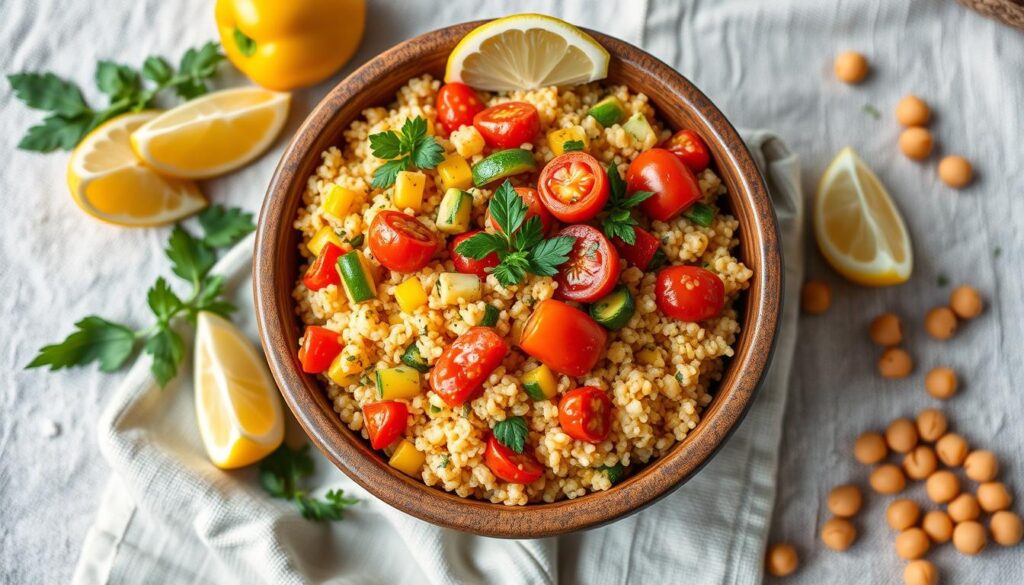
Making vegetarian couscous recipes is easy and fun. You can use couscous pearl or other types, and the steps are similar. These dishes are not only easy to make but also offer great flavors and textures.
Basic Cooking Instructions
The key to a delicious vegetarian couscous meal is in the cooking. Here’s how to do it:
- Boil the Liquid: First, boil a pot of water or vegetable broth. Broth makes the dish taste better than water.
- Add Couscous: When boiling stops, add couscous pearl. Cover and wait for 5 minutes.
- Fluff with a Fork: After soaking up the liquid, fluff the couscous with a fork. This makes it light and fluffy.
Troubleshooting Common Issues
Even simple recipes can have small problems. Here are tips for common issues:
- Clumping: To prevent clumps, fluff the couscous well with a fork after soaking.
- Bland Flavor: Use flavorful broth or add spices like cumin and oregano. Sauteed onions and garlic also help.
- Dry Texture: For dry couscous, add extra virgin olive oil and mix. It adds moisture and flavor.
By following these steps and tips, your vegetarian couscous meals will be a hit. Try different themes like Mediterranean or Mexican for new tastes. The secret is in the details—seasoning, cooking, and adding fresh herbs.
Vegetarian Couscous Recipes for Every Occasion
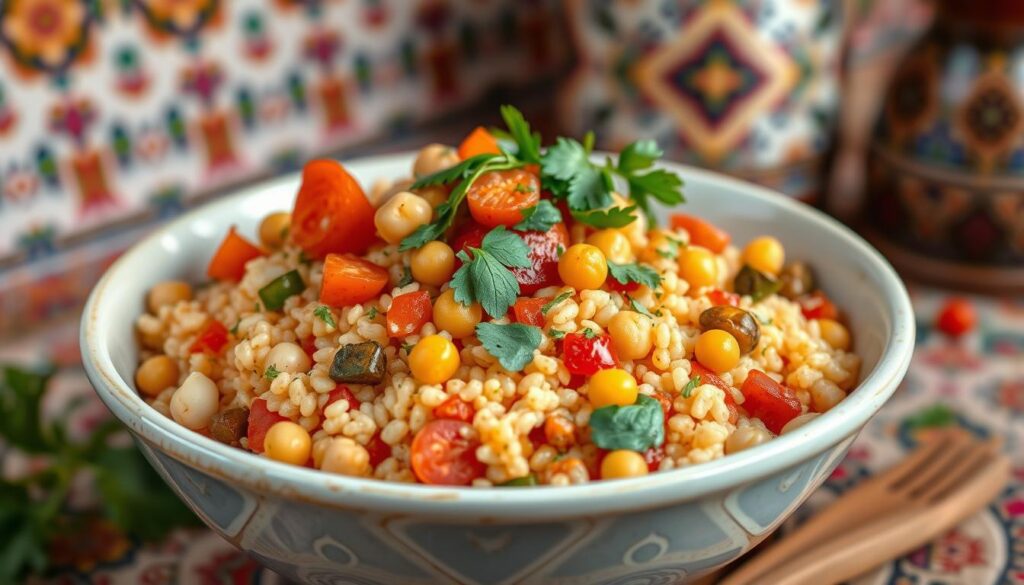
Vegetarian couscous recipes are perfect for any time. They’re great for quick dinners or special occasions. You’ll find the ideal moroccan couscous recipe for any event.
Quick Weeknight Dinners
On busy nights, couscous is a quick and healthy choice. It takes just 10 minutes to prepare and 15 minutes to cook. A favorite of mine is vegan pearl couscous with white beans.
This dish is fast and flavorful. It includes olive oil, yellow onion, garlic, and thyme. To make it, sauté aromatics for 5 minutes, toast the couscous for 1-2 minutes, and simmer it with navy beans and vegetable stock for 12-15 minutes. Add parsley, mint, and lemon juice at the end. It has 446 calories per serving and a 5-star rating, making it perfect for busy nights.
Festive and Special Occasion Recipes
For special events, add more ingredients to your couscous. Moroccan couscous with roasted vegetables is stunning. Use saffron, preserved lemons, and a variety of vegetables for a dish that looks as good as it tastes.
This couscous pilaf is luxurious and will wow your guests. It’s also healthy, thanks to navy beans and golden raisins. These ingredients add protein, fiber, and sweetness.
Whether it’s a quick dinner or a big celebration, vegetable couscous recipes are here to help. They’re easy to make, full of flavor, and sure to delight everyone.
Moroccan-Style Vegetable Couscous Recipes
Moroccan-style vegetable couscous is a mix of fragrant spices, hearty veggies, and fluffy couscous. This recipe is easy to follow and makes a tasty, healthy meal. Let’s explore the details!
Recipe Overview
This couscous recipe is great for family dinners or gatherings. It’s full of flavors from Moroccan veggies and spices. It serves 4-6 people and takes an hour to make, from start to finish.
Ingredients
- 1 large onion, chopped
- 4 cloves of garlic, minced
- 1/4 cup olive oil
- 3.3 cups chopped parsley
- 6 saffron threads, bloomed in 1/2 cup hot water
- 5 cups water
- 1 can drained chickpeas
- 4 medium carrots, chopped
- 2 large parsnips, chopped
- 1 sweet potato, chopped
- 1 large honey nut squash, chopped
- 1 large zucchini, chopped
- 4 oz mushrooms, sliced
- 2 tbsp butter
- Seasoning: cumin, cinnamon, ginger
Detailed Cooking Instructions
- Bloom saffron threads in hot water for 5 minutes.
- In a large pot, heat olive oil over medium heat, then sauté onions for 4-5 minutes until translucent.
- Add minced garlic, cook for an additional minute, then stir in chopped carrots, parsnips, sweet potato, and honey nut squash. Sauté for about 15-20 minutes.
- Pour in water, bloomed saffron, and spices. Bring to a simmer, then add chickpeas, zucchini, and mushrooms. Cook for an additional 10-15 minutes.
- Stir in butter and adjust seasoning as needed. Garnish with chopped parsley and couscous.
- Serve with high-fat cashew yogurt if desired.
Nutritional Information
| Component | Amount per Serving |
|---|---|
| Calories | 203.91 kcal |
| Carbohydrates | 26.09g |
| Protein | 4.33g |
| Fat | 9.43g |
| Saturated Fat | 1.31g |
| Polyunsaturated Fat | 1.08g |
| Monounsaturated Fat | 6.68g |
| Sodium | 395.1mg |
| Potassium | 167.35mg |
| Fiber | 2.57g |
| Sugar | 1.77g |
| Vitamin A | 901.64IU |
| Vitamin C | 34.88mg |
| Calcium | 24.39mg |
| Iron | 0.99mg |
Roasted Vegetable Couscous
Mixing roasted veggies with couscous makes a dish you’ll love. It serves 4 and is ready in just 10 minutes to prep and 35 minutes to cook. It’s a quick, satisfying meal.
Season the veggies with olive oil, salt, pepper, and garlic powder. Spread them on a baking sheet. Roast for 25-30 minutes until they’re tender and caramelized.
While roasting, cook the couscous. Boil water, salt, and turmeric. Add couscous, cover, and simmer for 10 minutes. Fluff it with a fork and mix in lemon juice, zest, and parsley.
Once the veggies are done, mix them with the couscous. Add chickpeas seasoned with garlic powder, paprika, and smoked paprika.
This dish is not only tasty but also healthy. Each serving has 580 calories, 89g carbs, 26g protein, 15g fat, 319mg sodium, and 21g fiber. It’s a balanced meal.
Want to try something different? Swap pearl couscous for quinoa for a gluten-free option. Add lentils or hemp seeds for more protein. Serve with vegan yogurt mint sauce.
This recipe is great as a main dish or side. Enjoy it cold for the best flavor. Store it in the fridge for up to 4 days, perfect for meal prep.
| Nutrient | Quantity (Per Serving) |
|---|---|
| Calories | 580 |
| Carbohydrates | 89g |
| Protein | 26g |
| Fat | 15g |
| Sodium | 319mg |
| Fiber | 21g |
| Vitamin A | 520IU |
| Vitamin C | 142mg |
| Calcium | 247mg |
| Iron | 8mg |
Vegetarian Couscous Recipes: Simple and Delicious
Making vegetarian couscous recipes is fun and rewarding. This grain is easy to cook and perfect for exploring new flavors. Here are some tips and ideas to start your couscous journey.
Preparation Tips
Use vegetable broth instead of water for a better flavor. Keep the liquid and couscous ratio at 1:1. Cooking couscous is quick, ready in just 5 minutes. Also, toast walnuts for 5 to 10 minutes until golden brown for a nice crunch.
Ingredient Variations
Keep your roasted vegetable couscous interesting with different ingredients. Try cherry tomatoes, mushrooms, zucchini, and bell peppers. You can also add squash or white beans for extra texture. Nuts like toasted walnuts add crunch, and cheese or grilled chicken can change the taste.
Serving Suggestions
Serving roast veggie couscous is versatile. It’s great as a main dish or side. Add yogurt or fresh herbs like parsley or basil for extra flavor. For a vegan option, use maple syrup instead of honey. The salad keeps well in the fridge for up to 4 hours, but add tomatoes and walnuts just before serving.
| Nutritional Content | Per Serving |
|---|---|
| Calories | 219 kcal |
| Protein | 5g |
| Carbohydrates | 29g |
| Dietary Fiber | 2g |
| Total Sugars | 4g |
| Total Fat | 9g |
| Saturated Fat | 1g |
| Cholesterol | 0mg |
| Sodium | 160mg |
By trying different variations and tips, your roasted vegetable couscous will always impress. It’s perfect for dinner parties or meal prep. These couscous dinner ideas will surely delight your taste buds.
Enhancing Your Couscous Dishes: Tips and Tricks
Improving your couscous dishes can be fun and creative. By carefully choosing flavors and how you present your dish, you can make every meal special. Whether it’s for a family dinner or a big event, these tips will help make your couscous stand out.
Flavor Pairings
To enhance your couscous, mix sweet and savory flavors. Try almond with apricot for a nutty and fruity taste. Or, cinnamon with sweet potato for a warm, cozy flavor.
Choosing the right sauce is key. Try a spiced yogurt or a rich tomato sauce to find the perfect match. A good sauce can turn a simple dish into a gourmet meal.
Presentation Ideas
How you present your dish matters a lot. Serve couscous in a big bowl with colorful veggies and herbs for a stunning look. Or, use molds to make couscous designs on plates for a fancy touch.
For individual servings, put couscous in the middle of plates with roasted veggies and a tasty sauce. This not only looks great but also makes sure every bite is full of flavor.
| Recipe | Servings | Prep Time | Cook Time | Total Time | Calories | Carbohydrates | Protein | Fat |
|---|---|---|---|---|---|---|---|---|
| Fall Harvest Couscous Skillet | 4 | 10 mins | 35 mins | 45 mins | 445 kcal | 67g | 16g | 14g |
| Enhanced Vegetarian Couscous | 2 | 20 mins | 10 mins | 40 mins | 966 kcal | 125g | 46g | 35g |
Side Dishes and Accompaniments to Serve with Couscous
To make your couscous morocco dish even better, try adding different side dishes and accompaniments. These extras not only make the meal more satisfying but also add new flavors.
Salads and Fresh Sides
Salads like Tabbouleh or mixed greens are great with couscous. They offer a refreshing crunch that contrasts well with the soft grains. A chickpea salad is also a good choice, adding a hearty texture.
Season these salads with a light vinaigrette. It will enhance the taste of your moroccan veggie couscous.
Sauces and Dressings
Adding sauces and dressings can really boost the flavor of your couscous. Tzatziki or lemon-tahini dressing adds a creamy touch. A tangy salsa or green chutney brings a zesty flavor.
These sauces not only make the couscous taste better but also add moisture. This makes each bite more enjoyable.
Protein Additions
If you want a more filling meal, consider adding protein like tofu, tempeh, or roasted chickpeas. These are great for vegetarians and vegans, adding texture and nutrition.
Options like tofu curry or chickpea stew go well with couscous. They offer a balanced and satisfying meal.
| Side Dish Name | Cooking Time (minutes) | Calories per Serving | Carbs (g) | Protein (g) | Fiber (g) |
|---|---|---|---|---|---|
| Tabbouleh | 15 | 150 | 18 | 4 | 3 |
| Mixed Greens | 10 | 50 | 5 | 2 | 1 |
| Chickpea Salad | 20 | 250 | 35 | 11 | 7 |
| Tofu Curry | 30 | 345 | 38 | 24 | 4 |
| Chickpea Stew | 40 | 320 | 42 | 18 | 6 |
Conclusion
Exploring vegetarian couscous recipes has shown us its endless possibilities. From traditional couscous maroc to quick pearl.couscous recipes, there’s something for everyone. We’ve seen many ingredients, cooking methods, and creative twists on classic dishes.
One big benefit of whole-wheat couscous is its nutritional value. It’s packed with fiber and protein, great for your heart and energy. It’s also rich in vitamins and minerals, making it a healthy choice for meals.
Modern production has made couscous easier to make, saving time. Whether you’re making a Moroccan dish or a new pearl couscous recipe, there’s a lot to discover. With the right liquid ratio and techniques like toasting, couscous can be a quick and tasty meal. So, start exploring the world of couscous and let your creativity shine!
